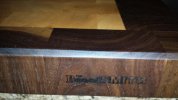One other thought on sanitation of cutting boards...
While wood tends to kill bacteria, including some resistant pathogens, not all materials do this, I do not believe it kills viruses, and the time frame it takes wood to do this is relatively short, but still not immediate (about 2-5 hours according to what I have read).
I have recently shifted my disinfectant from a few various cleaners to Accelerated Hydrogen Peroxide, or AHP. It's more or less very low concentration hydrogen peroxide (like 0.25% to 0.5%) enhanced by organic matter that increases the effectiveness. It only needs about a minute set time to kill virtually all of the food-borne pathogens that make people ill, and it can be used on virtually any surface including porous ones due to it being non-toxic (a huge limitation of bleach). I use this on plastic boards I put in the dishwasher as a pretreatment given how filthy raw chicken is and how it is becoming associated with certain pathogens that are resistant, and have started using it as a general kitchen cleaner and household disinfectant.
Diluted bleach on a wooden board is impractical because at that low concentration, even a set time of 15 minutes is not sufficient to kill many of pathogens that are relevant to the topic of food safety. AHP's short set time makes it more practical to effectively work, plus it does not have the toxicity that bleach does.
Effectiveness-wise, it is more effective than concentrated commercial bleach. It also kills certain resistant pathogens that not many disinfectants that are practical for the home can do. With how it works, concerns about it creating more resistant pathogens are very, very low when used correctly.

